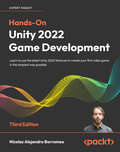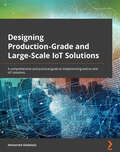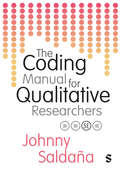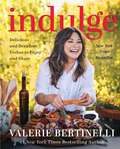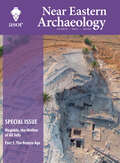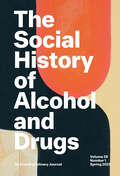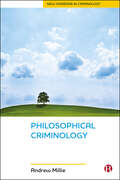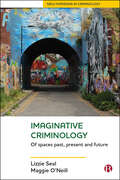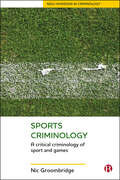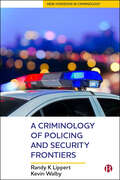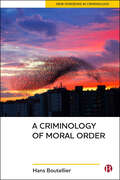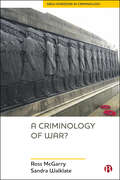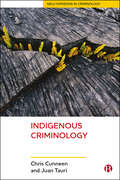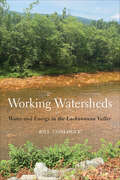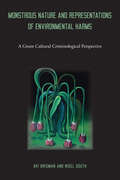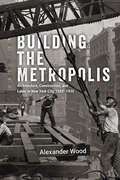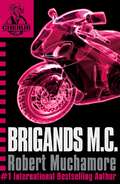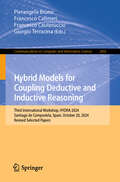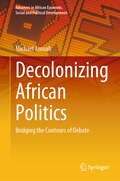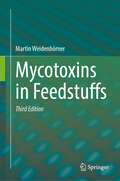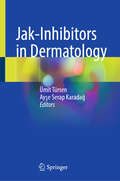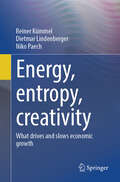- Table View
- List View
Hands-On Unity 2022 Game Development: Learn to use the latest Unity 2022 features to create your first video game in the simplest way possible, 3rd Edition
by Nicolas Alejandro BorromeoCreate, customize, and optimize your own professional games from scratch with Unity 2022Includes invitation to join the online Unity Game Development community to read the book alongside Unity developers/C# programmers and Nicolas Borromeo.Purchase of the print or Kindle book includes a free eBook in the PDF format.Key FeaturesCreate the game prototype and learn the fundamentals of Unity editor to build scenes, objects and import objectsAdd interactivity, win/lose conditions, sound, graphics and artificial intelligence using C# and visual scriptingImprove the game graphics, user interface, add visual effects and animations using Animator, Cinemachine, and TimelineBook DescriptionUnity is a cross-platform game engine that provides you with powerful but simple-to-use features to solve the most common problems in Game Development, such as rendering, animation, physics, sound, and effects. You'll learn to use these features to create simple but complete games (and all the nuances needed to handle Unity).Complete with hands-on tutorials and projects, this book will teach you to use the Unity game engine, create C# and visual scripts, integrate graphics, sound, and animations, and manipulate physics to create interesting mechanics for your game. You'll then code a simple AI agent to challenge the user and work with profiling tools to ensure code efficiency.Finally, you'll work with Unity's AR tools to create AR experiences for 3D apps and games before publishing them to the world.If you are interested in creating impressive, commercial-quality games that are playable on a variety of platforms, then you've come to the right place.What you will learnBuild a game prototype that includes gameplay, player and non-player characters, assets, animations, and moreSet up and navigate the game engine to dive into the Unity Editor and discover unique and new features released in 2022Learn both C# and Visual Scripting to customize player movements, the user interface, and game physicsApply shaders to improve your game graphics using Shader Graph and Universal Render Pipeline (URP)Create win-lose conditions for the game by using design patterns such as Singleton and Event ListenersImplement Game AI to build a fully functional enemy capable of detecting and attacking the playerDebug, test, optimize, and create an executable version of the game to share with your friendsWho this book is forBoth game and non-game developers who wish to migrate or start building 3D games in Unity will find this book useful. While you'll still able to follow along if you don't have any programming experience, knowing the fundamentals of C# programming will help you get the most out of this book.
Designing Production-Grade and Large-Scale IoT Solutions: A comprehensive and practical guide to implementing end-to-end IoT solutions
by Mohamed AbdelazizGet to grips with key IoT aspects along with modern trends, architectures, and technologies that support IoT solutions, such as cloud computing, modern app architecture paradigms, and data analyticsKey FeaturesUnderstand the big picture of designing production-grade IoT solutions from an industry expertGet up and running with the development and designing aspects of the Internet of ThingsSolve business problems specific to your domain using different IoT platforms and technologiesBook DescriptionWith the rising demand for and recent enhancements in IoT, a developer with sound knowledge of IoT is the need of the hour. This book will help you design, build, and operate large-scale E2E IoT solutions to transform your business and products, increase revenue, and reduce operational costs.Starting with an overview of how IoT technologies can help you solve your business problems, this book will be a useful guide to helping you implement end-to-end IoT solution architecture. You'll learn to select IoT devices; real-time operating systems; IoT Edge covering Edge location, software, and hardware; and the best IoT connectivity for your IoT solution. As you progress, you'll work with IoT device management, IoT data analytics, IoT platforms, and put these components to work as part of your IoT solution. You'll also be able to build IoT backend cloud from scratch by leveraging the modern app architecture paradigms and cloud-native technologies such as containers and microservices. Finally, you'll discover best practices for different operational excellence pillars, including high availability, resiliency, reliability, security, cost optimization, and high performance, which should be applied for large-scale production-grade IoT solutions.By the end of this IoT book, you'll be confident in designing, building, and operating IoT solutions.What you will learnUnderstand the detailed anatomy of IoT solutions and explore their building blocksExplore IoT connectivity options and protocols used in designing IoT solutionsUnderstand the value of IoT platforms in building IoT solutionsExplore real-time operating systems used in microcontrollersAutomate device administration tasks with IoT device managementMaster different architecture paradigms and decisions in IoT solutionsBuild and gain insights from IoT analytics solutionsGet an overview of IoT solution operational excellence pillarsWho this book is forThis book is for E2E solution architects, systems and technical architects, and IoT developers looking to design, build, and operate E2E IoT applications and solutions. Basic knowledge of cloud computing, software engineering, and distributed system design will help you get the most out of this book.
The Coding Manual for Qualitative Researchers
by Johnny SaldañaUnlock the full potential of your qualitative research projects with this invaluable manual from world-renowned authority Johnny Saldaña. This essential guide delves into the latest advancements in coding, including the integration of AI tools like ChatGPT-4, empowering researchers to enhance their data analysis processes and outcomes. This clearly updated edition offers: · Comprehensive Coverage: Explore over 35 coding methods, complete with datasets, software screenshots, and multidisciplinary academic references. · Global Appeal: Designed for an international readership, with inclusive data and real-world examples. · Practical Guidance: Clear, academically grounded advice that bridges the gap between data generation and analysis, ensuring credibility and trustworthiness. · Modern Relevance: Facilitates both manual and online coding, with detailed insights into CAQDAS and digital data handling. Ideal for students, researchers, and professionals in education, the social sciences, and beyond, this manual with its’ accompanying online resources is your go-to reference for mastering qualitative coding and data analysis in the AI era.
The Coding Manual for Qualitative Researchers
by Johnny SaldañaUnlock the full potential of your qualitative research projects with this invaluable manual from world-renowned authority Johnny Saldaña. This essential guide delves into the latest advancements in coding, including the integration of AI tools like ChatGPT-4, empowering researchers to enhance their data analysis processes and outcomes. This clearly updated edition offers: · Comprehensive Coverage: Explore over 35 coding methods, complete with datasets, software screenshots, and multidisciplinary academic references. · Global Appeal: Designed for an international readership, with inclusive data and real-world examples. · Practical Guidance: Clear, academically grounded advice that bridges the gap between data generation and analysis, ensuring credibility and trustworthiness. · Modern Relevance: Facilitates both manual and online coding, with detailed insights into CAQDAS and digital data handling. Ideal for students, researchers, and professionals in education, the social sciences, and beyond, this manual with its’ accompanying online resources is your go-to reference for mastering qualitative coding and data analysis in the AI era.
Indulge: Delicious and Decadent Dishes to Enjoy and Share
by Valerie BertinelliInstant New York Times bestsellerBeloved actress and New York Times bestselling author Valerie Bertinelli returns with her most indulgent cookbook yet; a collection of 100 recipes to nourish the body and the soul.in·dulge: to allow oneself to enjoy the pleasure of.When Valerie Bertinelli turned 60, she said “Enough already!” and ended her battle with the scale for good. She stopped counting calories. She stopped thinking of certain foods as good or bad. She quit saying no and began saying yes, finally learning how to enjoy the pure pleasure of being alive – starting in the kitchen. In short, she learned how to indulge.With this gorgeous cookbook, Valerie shares her secrets for indulging so you can start living your best, most fulfilling life too. Whether it’s splurging on fresh produce at the farmer’s market, cooking an extravagant steak dinner for one, or serving an ice cream sundae bar at a dinner party, this book is a reminder that indulging can take many shapes and forms.You’ll discover the delicious recipes she cooks for her friends and family, including favorites like Garlic Confit BLT, Oven “Fried” Okra, Sausage and Olive Cheese Bites, Spaghetti al Limone, Salmon Burgers With Quick-Pickled Vegetables, Filet Mignon with Béarnaise Sauce and Chocolate Peanut Butter Dates, and more. Written in Valerie’s warmhearted and intimate style—including heartfelt essays about how to savor moments big and small—this cookbook is a permission slip to enjoy food, and more importantly, enjoy life.
Near Eastern Archaeology, volume 88 number 2 (June 2025)
by Near Eastern ArchaeologyThis is volume 88 issue 2 of Near Eastern Archaeology. Archaeological discoveries continually enrich our understanding of the people, culture, history, and literature of the Middle East. The heritage of its peoples—from urban civilization to the Bible—both inspires and fascinates. Near Eastern Archaeology brings to life the ancient world from Mesopotamia to the Mediterranean with vibrant images and authoritative analyses.
The Social History of Alcohol and Drugs, volume 39 number 1 (Spring 2025)
by The Social History of Alcohol and DrugsThis is volume 39 issue 1 of The Social History of Alcohol and Drugs. The Social History of Alcohol and Drugs: An Interdisciplinary Journal (SHAD) is a peer-reviewed academic journal dedicated to publishing high-quality original academic research, reflection essays, and reviews in the field of alcohol and drug history, broadly construed. SHAD appears twice annually as an official publication of the Alcohol and Drugs History Society, which promotes scholarship and discussions about the history of alcohol and drug use, abuse, production, trade, and regulation across time and space.
Philosophical Criminology (New Horizons in Criminology)
by Andrew MilliePhilosophical criminology asks big questions about how we get on with one another and what happens when we do not. This accessible book in the New Horizons in Criminology series is the first to foreground this growing area. The book is structured around six philosophical ideas concerning our relations with others: values, morality, aesthetics, order, rules and respect. Building on the author’s theoretical and empirical research, the book considers the boundaries of criminology and the scope for greater exchange between criminology and philosophy. The book is illustrated using examples from a range of countries, and provides a platform for engaging with important topical issues using philosophical and theoretical insights.
Imaginative Criminology: Of Spaces Past, Present and Future (New Horizons in Criminology)
by Maggie O'Neill Lizzie SealThis distinctive and engaging book proposes an imaginative criminology, focusing on how spaces of transgression are lived, portrayed and imagined. These include spaces of control or confinement, including prison and borders, and spaces of resistance. Examples range from camps where asylum seekers and migrants are confined, to the exploration of deviant identities and the imagined spaces of surveillance and control in young adult fiction. Drawing on oral history, fictive portrayals, walking methodologies, and ethnographic and arts-based research, the book pays attention to issues of gender, sexuality, age, ethnicity, mobility and nationality as they intersect with lived and imagined space.
Sports Criminology: A Critical Criminology of Sport and Games (New Horizons in Criminology)
by Nic GroombridgeThis is the first book to provide a critical criminological perspective on sport and the connections between sport and crime. It draws on the inter-disciplinary nature of criminology and incorporates emerging perspectives like social harm, gender and sexuality, and green criminology. Written from an international perspective, it covers topics including sports scandals and the possibility of crime prevention through sport. American football, boxing, soccer and sumo are all examined. The book considers both sports law and the sociology of sport and will be essential reading for students and academics in these fields.
A Criminology of Policing and Security Frontiers (New Horizons in Criminology)
by Kevin Walby Randy K LippertPolicing and security provision are subjects central to criminology. Yet there are newer and neglected forms that are currently unscrutinised. By examining the work of community safety officers, ambassador patrols, conservation officers, and private police foundations, who operate on and are animated by a frontier, this book reveals why criminological inquiry must reach beyond traditional conceptual and methodological boundaries in the 21st century. Including novel case studies, this multi-disciplinary and international book assembles a rich collection of policing and security frontiers both geographical (e.g. the margins of cities) and conceptual (dispersion and credentialism) not seen or acknowledged previously.
A Criminology of Moral Order (New Horizons in Criminology)
by Hans BoutellierMoral order is disturbed by criminal events. However, in a secularized and networked society a common moral ground is increasingly hard to find. People feel confused about the bigger issues of our time such as crime, anti-social behaviour, Islamist radicalism, sexual harassment and populism. Traditionally, issues around morality have been neglected by criminologists. Through theory, case studies and discussion, this book sheds a new and topical light on these concerns. Using the moral perspective, Boutellier bridges the gap between people’s emotional opinions on crime, and criminologists' rationalized answers to questions of crime and security.
A Criminology of War? (New Horizons in Criminology)
by Sandra Walklate Ross McGarryIn recent years, the academic study of ‘war’ has gained renewed popularity in criminology. This book illustrates its long-standing engagement with this social phenomenon within the discipline. Foregrounding established criminological work addressing war and connecting it to a wide range of extant sociological literature, the authors present and further develop theoretical and conceptual ways of thinking critically about war. Providing a critique of mainstream criminology, the authors question whether a ‘criminology of war’ is possible, and if so, how this seemingly ‘new horizon’ of the discipline might be usefully informed by sociology.
Indigenous Criminology (New Horizons in Criminology)
by Chris Cunneen Juan TauriIndigenous Criminology is the first book to comprehensively explore Indigenous people’s contact with criminal justice systems in a contemporary and historical context. Drawing on comparative Indigenous material from North America, Australia and Aotearoa New Zealand, it addresses both the theoretical underpinnings to the development of a specific Indigenous criminology, and canvasses the broader policy and practice implications for criminal justice. Written by leading criminologists specialising in Indigenous justice issues, the book argues for the importance of Indigenous knowledges and methodologies to criminology, and suggests that colonialism needs to be a fundamental concept to criminology in order to understand contemporary problems such as deaths in custody, high imprisonment rates, police brutality and the high levels of violence in some Indigenous communities. Prioritising the voices of Indigenous peoples, the work will make a significant contribution to the development of a decolonising criminology and will be of wide interest.
Working Watersheds: Water and Energy in the Lackawanna Valley
by William ConlogueA personal narrative, an examination of literary texts, and a history of the Lackawanna Valley region, Bill Conlogue’s Working Watersheds explores how water has circulated in the former anthracite capital of the world. Conlogue not only recounts water’s use in anthracite mining and textile making, but also investigates its resulting pollution. He delves into the current natural gas boom, which threatens groundwater, and concludes with hopes of environmental renewal and restoration. Offering a fresh way to think about the Anthropocene, this distinctive history of water and coal in the Lackawanna Valley discusses how both water abundance and scarcity might play out as global temperatures rise. Working Watersheds is designed to trigger debates about the nature of history, the significance of literature, and the importance of linking person, place, and planet in an era of climate change.
Monstrous Nature and Representations of Environmental Harms: A Green Cultural Criminological Perspective
by Avi Brisman Nigel SouthHow does culture influence human relationships with the environment? In Monstrous Nature and Representations of Environmental Harms, green cultural criminologists Avi Brisman and Nigel South examine stories of monsters and disasters to address how the ways we depict and think about harms to the environment dissuade us from taking care of our planet and each other. The authors use examples from popular culture, including Disney and Marvel Cinematic Universe films, to consider ideas about how the environment responds to people who cause it harm. Brisman and South identify and discuss three dominant and interrelated depictions of the relationship between humans and the environment: first, nature as monstrous or fear inducing; second, nature and the Earth (or parts of it) as abject; and third, the entanglement of nature and the apocalypse, wherein nature is contributing to the end of the world, with an end point sometimes conceptualized as one without humans. Monstrous Nature and Representations of Environmental Harms argues that such representations have material consequences. The authors make the case for challenging them so that we neither perpetuate them nor retreat into cynicism and defeatism about the future of our planet.
Advancing Immigrant Rights in Houston (PLAC: Political Lessons from American Cities)
by Shannon Gleeson Els de GraauwHouston is one of the most diverse cities in the United States and has long been a prime destination for international migrants from Latin America, Asia, and more recently, Africa. However, the city is politically mixed, organizationally underserved, and situated in a relatively anti-immigrant state. This makes Houston a challenging context for immigrant rights despite its rapidly diversifying population. In Advancing Immigrant Rights in Houston, Els de Graauw and Shannon Gleeson recount how local and multi-level contexts shape the creation, contestation, and implementation of immigrant rights policies and practices in the city. They examine the development of a city immigrant affairs office, interactions between local law enforcement and federal immigration enforcement officials, local public-private partnerships around federal immigration benefits, and collaborations between labor, immigrant rights, faith, and business leaders to combat wage theft. The case study of Houston provides a bellwether for how other U.S. cities will deal with their growing immigrant populations and underscores the importance of public-private collaborations to advance immigrant rights.
Building the Metropolis: Architecture, Construction, and Labor in New York City, 1880–1935 (Historical Studies of Urban America)
by Alexander WoodA sweeping history of New York that chronicles the construction of one of the world’s great cities. Between the 1880s and the 1930s, New York City experienced explosive growth as nearly a million buildings, dozens of bridges and tunnels, hundreds of miles of subway lines, and thousands of miles of streets were erected to meet the needs of an ever-swelling population. This landscape—jagged with skyscrapers, rattling with the sound of mass transit, alive with people—made the city world-famous. Building the Metropolis offers a revelatory look at this era of urban development by asking, “Who built New York, and how?” Focusing on the work of architects, builders, and construction workers, Alexander Wood chronicles the physical process of the city’s rapid expansion. New York’s towering buildings and busy thoroughfares aren’t just stylish or structural marvels, Wood shows, but the direct result of the many colorful personalities who worked in one of the city’s largest industries. This development boom drew on the resources of the whole community and required money, political will, creative vision, entrepreneurial drive, skilled workmanship, and hard physical labor. Wood shows this to be an even larger story as well. As cities became nodes in a regional, national, and global economy, the business of construction became an important motor of economic, political, and social development. While they held drastically different views on the course of urban growth, machine politicians, reformers, and radicals alike were all committed to city building on an epic scale. Drawing on resources that include city archives and the records of architecture firms, construction companies, and labor unions, Building the Metropolis tells the story of New York in a way that’s epic, lively, and utterly original.
Brigands M.C.: Book 11 (CHERUB #11)
by Robert MuchamoreEvery CHERUB agent comes from somewhere. Dante Scott still has nightmares about the death of his family, brutally murdered by a biker gang. Dante is given the chance to become a member of CHERUB, a trained professional with one essential advantage: adults never suspect that children are spying on them. But when Dante joins James and Lauren Adams on a mission to infiltrate Brigands Motorcycle Club, he's ready to use everything he's learned to get revenge on the people who killed his family ...For official purposes, these children do not exist.
Hybrid Models for Coupling Deductive and Inductive Reasoning: Third International Workshop, HYDRA 2024, Santiago de Compostela, Spain, October 20, 2024, Revised Selected Papers (Communications in Computer and Information Science #2492)
by Francesco Calimeri Giorgio Terracina Pierangela Bruno Francesco CauteruccioThis book constitutes the refereed proceedings of the Third International Workshop on Hybrid Models for Coupling Deductive and Inductive Reasoning, HYDRA 2024, held in Santiago de Compostela, Spain, on October 20, 2024. The 6 full papers and 1 invited talk included in this book were carefully reviewed and selected from 7 submissions.The International Workshop on Hybrid Models for Coupling Deductive andInductive Reasoning (HYDRA) was designed as a forum for researchers to explore the exciting possibilities at the intersection of deductive and inductive reasoning.
Placing the Future (Knowledge and Space #20)
by Johannes Glückler Matthias Garschagen Robert PanitzThis open access book offers a fresh perspective on the uncertainties of the future that humanity faces. Leading scholars from the fields of future studies, planning, geography, history, sociology, design, and the humanities sensitize for the intricate role of geography in building knowledge to anticipate probable, to imagine alternative, and to enact desirable futures. Part I, knowing the future, explores strategies for anticipating possible futures, such as foresight methods, scenarios, and guiding images. This section underscores the importance of cultivating future consciousness to confront societal denial of looming threats like environmental crises. Part II, envisioning the future, delves into various ways societies imagine their futures, exploring topics like the future of food, post-growth economies, extra-terrestrial futures, and even human self-extinction to reveal how futurist scenarios can inform decision making and proactive planning. Part III, enacting the future, focuses on the performative aspects of futuring. The authors in this section examine practices—such as designing, performing, advising, and governing—that are aimed at transforming desired futures into present realities. As part of a series on the interdisciplinary nexus between knowledge and space, this book is an essential resource for researchers, policy makers, planners, students, and practitioners in the fields of sustainability, future studies, regional development, and governance.
Decolonizing African Politics: Bridging the Contours of Debate (Advances in African Economic, Social and Political Development)
by Michael AmoahThis book serves as a unique contribution to the curriculum decolonizing agenda currently trending in universities. It approaches Politics and International Relations from the postcolonial and decolonial perspectives with empirical rebuttals to existing imperial and neocolonial false narratives. It examines key concepts and topics which regularly feature when teaching or discussing Africa at universities, such as: nationhood and nationalisms; neo-patrimonialism; arbitrary borders and tribes; françafrique; superpower relations; relationships with China & Russia; South-South cooperation and collaborations; foreign interventions; global justice; global governance and reform of the UN Security Council. This book explores the etymologies of these concepts or topics and their terminological application to Africa while bringing fresh perspectives to the debate. It appeals to scholars and students of African politics and international relations, and functions as a graduate and advanced under-graduate pedagogical tool.
Mycotoxins in Feedstuffs
by Martin WeidenbörnerThe third edition features a re-organization into multiple sections including: Mycotoxin Contamination in Feedstuffs for Farm Animals; Mycotoxin Contamination in Feedstuffs for Pets; Further Mycotoxins and Microbial Metabolites in Feedstuffs; Tables of Mycotoxins in Feedstuffs; Feedstuffs for Farm Animals and their Mycotoxins; Feedstuffs for Pets and their Mycotoxins; Mycotoxin Contamination of Feedstuffs in Conventional and Organic Farming; and Geographical Occurrence of Mycotoxins in Feedstuffs.
Jak-Inhibitors in Dermatology
by Ayşe Serap Karadağ Ümit TürsenThis book covers the clinical usage of JAK inhibitors, which target Janus kinases and have shown promising results in the treatment of various dermatologic conditions, including atopic dermatitis, psoriasis, vitiligo, connective tissue disorders, autoimmune bullous diseases and alopecia areata. It is likely that JAK inhibitors will continue to play an important role in the management of these conditions, with clinical trials ongoing to assess their safety and efficacy in the treatment of other dermatologic disorders, such as vitiligo and hidradenitis suppurativa. However, it is important to note that JAK inhibitors can have potential side effects, including increased risk of infections, anemia and thrombosis. Therefore, careful monitoring of patients receiving JAK inhibitors is necessary to ensure their safety.Jak Inhibitors in Dermatology represents a treatise on this novel topic and discusses that while JAK inhibitors have shown great promise in the treatment of various dermatologic conditions, further research and monitoring is necessary to fully understand their potential benefits and risks. This book is therefore of great interest for all dermatologists as a first step to understanding this novel treatment.
Energy, entropy, creativity: What drives and slows economic growth
by Reiner Kümmel Dietmar Lindenberger Niko PaechThis book helps to understand the importance of thermodynamics for economics, the environment and society. It argues for the integration of the first two laws of thermodynamics into textbook economics. In doing so, systemic similarities in thermodynamics and the theory of economic growth lead to the use of similar mathematical methods that allow industrial economies to be described realistically. From this, the authors propose tools for solving social and environmental problems. The book is aimed at all those interested in interdisciplinary research on the development problems of the economy and society and who want to understand what drives their upheavals. The authors of the book have been dealing with these development problems for a long time: the theoretical physicist Reiner Kümmel from the University of Würzburg, the physicist and economist Dietmar Lindenberger from the University of Cologne and the Energy Economics Institute at this university, and the economist Niko Paech from the University of Siegen. "It is my pleasure to recommend this book to readers. It is driven by the idea of exploring the physical limits of human economic activity using thermodynamics, one of the most universal physical theories we have." Comment on the original German edition by Dieter Meschede, Professor of Physics, University of Bonn
